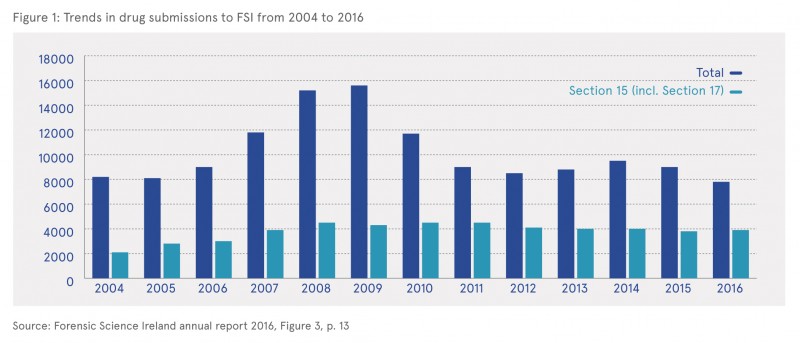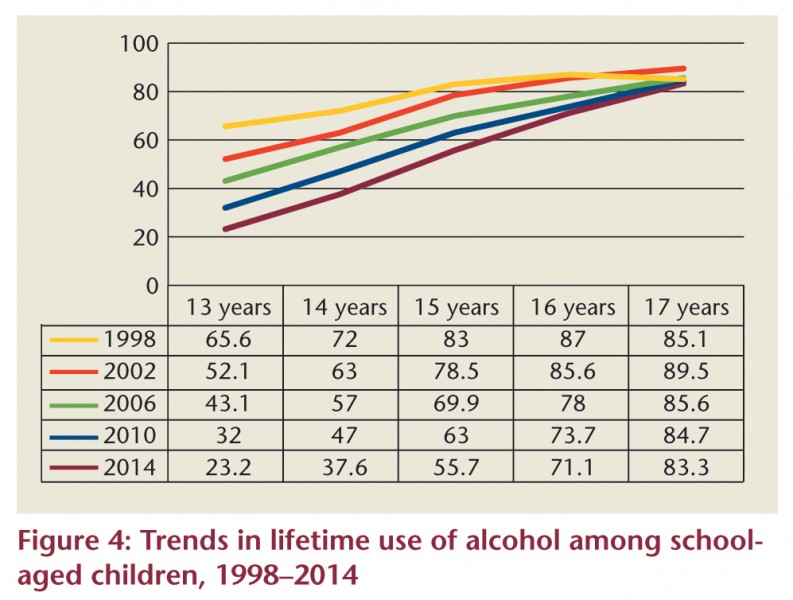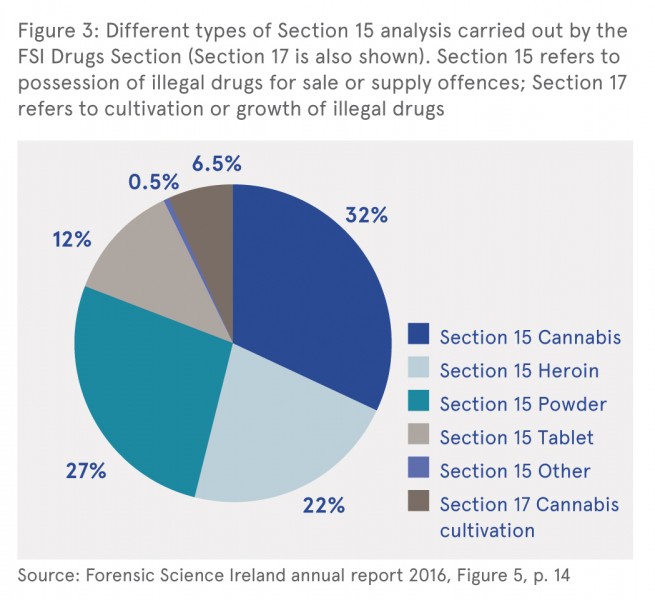Guiney, Ciara (2018) Forensic Science Ireland: annual report 2016. Drugnet Ireland, Issue 64, Winter 2018, p. 30.
| Preview | Title | Contact |
|---|---|---|
|
PDF (Issue 64, Winter 2018)
- Published Version
933kB |
Forensic Science Ireland (FSI), originally known as the Forensic Science Laboratory, delivers a scientific service that supports the Irish criminal justice system by analysing samples that are gathered at crime scenes (e.g. DNA, chemistry, and drugs). Moreover, it presents expert evidence in court, provides training, and carries out research. In order to do this effectively, scientists and analysts within the FSI draw on best international standards. In May 2017, the FSI published their annual report, which provided an overview of work carried out in relation to drugs in the course of 2016.1
The majority of cases received by FSI centre on substances that violate the Misuse of Drugs Acts 1977—2015. Generally, substances are seized by An Garda Síochána; however, they are also submitted by the Garda Síochána Ombudsman Commission (GSOC), Customs and Excise, and Military Police. A set procedure is in place to accept cases; following acceptance of substances by FSI reception or case intake staff, items are stored safely and securely and then passed to a relevant scientist for analysis. At all times the chain of custody is closely monitored.
Figure 1 provides a summary of drug trends between 2004 and 2016 for drugs that were submitted to FSI for analysis. Following a peak in overall drug submissions in 2009, submissions declined until 2012. Between 2012 and 2014 a slight increase was evident. Since 2014, a slight decreasing trajectory has been shown. A further analysis for drugs that contravene Sections 15 and 17 of the Misuse of Drugs Acts illustrated that between 2008 and 2016 the changes year on year have been very small.

Figure 2 provides a summary of the number of cases analysed by drug type that contravened Section 3 of the Misuse of Drugs Acts in 2016. The majority of cases submitted were for cannabis (44%), followed by powder, and then heroin, 24% and 20.7%, respectively.

Similarly, under Section 15, the prevailing drug submitted was cannabis (32%), followed by powder and heroin, 27% and 22%, respectively, while under Section 17, cannabis cultivation accounted for 6.5% of the analysis performed (see Figure 3).

New substances
A number of new drugs were identified in Ireland in 2016, including:
Benzodiazepine drugs: phenazepam, nitrazolam, etizolam, chlorodiazepam
Cathinone (stimulant) drugs: pentylone, dipentylone, dibutylone, ethylhexedrone, N-ethylpentedrone, α-PVP, clephedrone, MPHP, PV8 (α-PHP), PV9 (α-POP), chloro-PVP, 4-chloro-α-PPP
Synthetic cannabinoids: 5F-MDMB-PINACA, 5F-AKB-48, 5F-PB-22
Tryptamines (stimulant) drugs: methyltryptamine, dimethyltryptamine, 5-MeO MiPT
NBOMes: 25I-NBOMe
Fentanyl (opiate-type) drugs: fentanyl, pentanoyl fentanyl, 2-flourofentanyl
Other drugs: 3-flourophenmetrazine (stimulant-type drug)
The emergence of new substances creates a challenge for FSI, as no reference standards are available to which they can be compared. Moreover, individuals that use these new products are at higher risk, as toxicity levels are substantially higher than similar drugs. For example, the report refers to a case that occurred at a house party attended by young people in Cork in 2016. Powder that was assumed to be a designer drug called 2CB was consumed and high levels taken as a result. FSI later identified the powder as 24I-NBOMe (N-Bomb), a toxic hallucinogenic drug. In this instance, the amount consumed was one hundred times higher than the normal dose and resulted in the death of one young male.
Court appearances
In 2016, requests for FSI to appear in court were low. Despite this, defence teams visited FSI on a number of occasions, many of which were connected to the reassessment of drug seizures (n=34).
Purity
Purity levels in cocaine were generally 40%. A number of other compounds were found, such as levamisole (used by vets), benzocaine and lignocaine (used by dentists) and phenacetin (used as an illegal painkiller). With regard to heroin, purity levels were about 33%, and other compounds present included combinations of phenacetin, paracetamol, and caffeine.
Out-of-hours service
An out-of-hours service consisting of one scientist and a small team (n=20) were at hand to attend crime scenes and carry out laboratory work when needed. Overall, urgent drug analysis was required seven times and crime scene visits occurred 14 times, one of which was to a clandestine drug laboratory.
1 Forensic Science Ireland (2017) Forensic Science Ireland annual report 2016. Dublin: Forensic Science Ireland. https://www.drugsandalcohol.ie/27308/
J Health care, prevention, harm reduction and treatment > Identification and screening > Identification and screening for substance use
MM-MO Crime and law > Substance related offence > Drug offence > Illegal distribution of drugs (drug market / dealing)
MM-MO Crime and law > Substance related offence > Drug offence > Illegal drug possession (seizures)
VA Geographic area > Europe > Ireland
Repository Staff Only: item control page